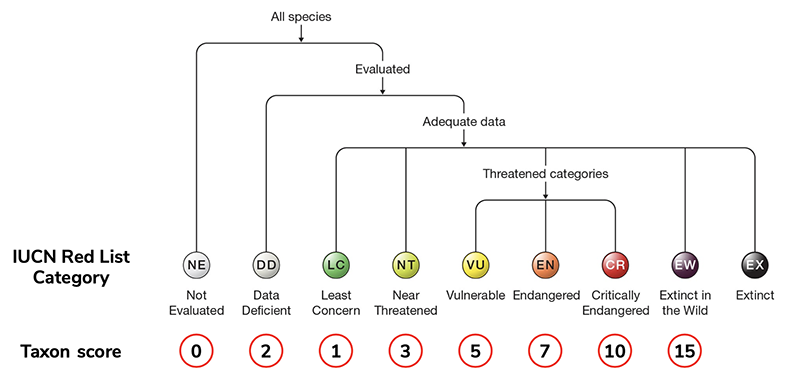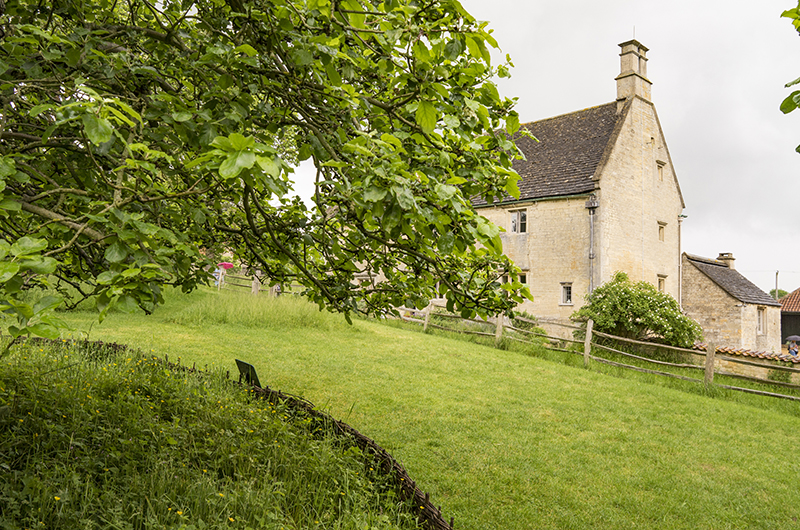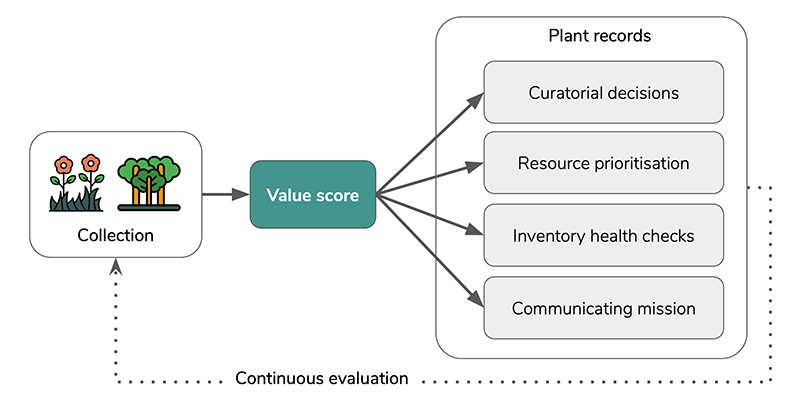Our last webinar on the 12th of August was all about Collection Value Scoring. No matter the mission and focus of your garden and collection, there is always the question of how you can better understand and communicate the value of your plant collection.
In a normal world, this could be its monetary value – but what is the value of the collection to your garden? And how does this relate to its mission and purpose? These are some of the interesting questions we explored in our webinar.
Communicating the value of a collection is at the heart of why a garden exists. A garden’s mission captures its main aspirations, identifying specific goals and objectives in line with the institution’s target audience. It also provides direction in terms of the Collections Policy.
How the garden’s mission and purpose are understood and interpreted varies between different institutions, departments and staff, and only a few gardens use metrics to actively measure their plant collection.
A better understanding of the value of a plant collection can help with making efficient decisions, guiding collection development and highlighting opportunities for data improvements.

Case Studies: Applications of Value Scoring
2012 BGCI survey of Rhododendron
An example of how collection value scoring has been applied in a conservation context, is with the BGCI’s Global Survey of ex situ Rhododendron collections. This work, published in 2012, investigated 75 Rhododendron taxa that were on the verge of extinction in the wild.
One of the aims of this study was to gauge how representative global collections are, in terms of size and whether the collection is derived from known wild sources or not. Based on IUCN categories, the most “significant” collections of Rhododendron were determined by assigning a score for each taxon:

Using this value scoring approach, the aim was to strengthen existing ex situ collections and help guide the establishment of new collections. It also formed a strong basis with which to set conservation priorities and action (e.g. for the The Red List of Rhododendrons).
The Dawes Arboretum
At The Dawes Arboretum, multiple criteria are used to quantify the value of accessions within the collection. These binary questions mean that if an accession receives more “Yes” answers, it is considered more valuable.
- Is this accession collected in the wild with precise collection data (if wild-origin)?
- Is the plant material of the accession difficult to obtain?
- Is the accession propagated from the originally named “type” specimen (if a cultivar)?
- Is the accession taxonomically verified true-to-name?
- Is this taxon the only specimen in the collection, a unique accession, or otherwise important?
- Is this plant healthy and likely to thrive?
- Is this taxon/accession uncommon in the trade or in cultivation?
- Is the site where this plant is located within the collection secured and less apt to experience disturbance from future construction or development?
Cambridge University Botanic Garden
At Cambridge University Botanic Garden, there are also a number of key metrics that influence the Living Collections Strategy and how it meets the garden’s goals of research, education, and conservation. These quality metrics are used to explore how “value” is distributed among the different parts of the collection, and guide improvements to their management.
One interesting aspect to mention in this case, is the use of external datasets such as conservation status, provided by IUCN or ex-situ diversity from BGCI. Using external datasets is decidedly more challenging, but the reward is that it enables you to measure your collection in a global or regional context. With integration options becoming more available, we can expect these external datasets to play a more active role in value scoring workflows.

National Trust
Value scoring is also relevant for gardens with historical and cultural missions such as the National Trust. At such institutions, plants may be among the earliest introductions of that taxon, or intrinsically linked with historic events or people. Many of these plants cannot be replaced, due to their unique genetic make-up or unique horticultural heritage.
Examples of such “historic” plants include the ‘Newton Wonder’ apple cultivar at Woolsthorpe Manor, which was said to have inspired Sir Isaac Newton’s theory of gravity. Another is the Knightshayes gentian (Gentiana asclepiadea ‘Knightshayes’). This was an inspirational gift to the owners at Knightshayes Court, encouraging them to create their garden in the first place.

Collection Value Scoring in a dynamic garden
Living plant collections have a dynamic nature. Understanding the value of your collection at the current moment in time can be helpful in prioritising the type of care and curatorial work that is dedicated to them in the short-term. However, quantifying how your collection is changing can open up interesting questions about how well your collection is managed.
For example, all data associated with your collection has a shelf-life. If plant records are seldom updated, there is a higher likelihood that the plant may end up in the compost heap. A robust value scoring model can help keep track of your inventory, and encourage you to address issues with stale data or plant material that has not been reviewed in a while.

The Value of Scoring
How else might value scoring be applied across a garden’s mission? Our breakout discussions made it clear that this prospect has far-reaching implications: from reporting collections’ progress to stakeholders, to disaster preparedness and even visitor interpretation. To view our whiteboard notes, click here.
Beyond knowing the value of your collection, it is important for gardens to use these types of insights for practical, actionable outcomes. Articulating this in the Collections Policy means you can communicate the value of your living collection, both internally and externally.
Benchmarking within your own collection over time also allows you to set realistic goals, make better-informed curatorial decisions, and maintain a healthy inventory of plant records. It is a continuous process that a robust model can help achieve, no matter your garden’s mission.
We are excited to explore this topic in more detail on our journey ahead together with the community.

Join us at our next webinar on 7th October 2021
Healthy Plant Records: Are they achievable?
Plant records are at the heart of gardens amongst an increasingly data-driven world. To make effective use of plant records, the data must be kept accurate and up-to-date.
Are there ways of quantifying the quality of your plant records, to give an indication of its health? What exactly does a healthy plant records system mean? And how is this achievable?
Join us to find out more.
For more details on how to sign up, visit: https://botanicalsoftware.com/events/event/plant-records-webinar/
To view other webinars from our Plant Records series, go to the Botanical Software Youtube Channel.
